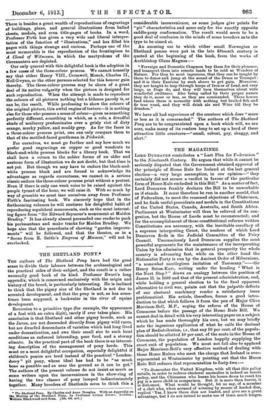THE SHETLAND PONY.*
THE authors of The Shetland Pony have had the good sense to divide their labours between the archaeological and the practical sides of their subject, and the result is a rather unusually good book of its kind. Professor Ewart's long appendix, which is concerned exclusively with the origin and history of the breed, is particularly interesting. He is inclined to think that the pigmy size of the Shetland is not due to arrested development, and that the pony is not, as has some- times been supposed, a backwater in the river of equine development.
Reversion to a primitive type (for example, the appearance of a foal with an extra digit), rarely if ever takes place. His conclusion is that Shetland and other pigmy breeds, such as the Javan, are not descended directly from pigmy wild races, but are dwarfed descendants of varieties which bad long lived under domestication, and owe their small size to such local conditions as enforced inbreeding, poor food, and a stormy climate. In the practical part of the book there is an interest- ing description of the management of pony herds. This must oe a most delightful occupation, especially delightful if children's ponies are bred instead of the practical "London- derry " pit pony, whose ideal has had to be "as much bone as possible and as near the ground as it can be got." The authors of the present volume do not insist as much as some writers upon the inconvenience in the show-ring of having the two classes of pony lumped indiscriminately together. Many breeders of Shetlands seem to think this a
• The Shetland Pony. By Charles and Anne Douglas. With an Appendix on the Making of the Shetland Pony, by Professor Cossar Ewan. London ; William Blackwood and Sons. 1105. fnl. net.]
considerable inconvenience, as some judges give points for "pit" characteristics and some only for the exactly opposite saddle-pony conformation. The result would seem to be a good deal of confusion in the minds of some breeders as to the type to be aimed at.
An amusing use to which either small Norwegian or Shetland ponies were put in the late fifteenth century is quoted at the beginning of the book, from the works of Archbishop Olans Magnus :—
" Forraign and Domestic Chapmen buy them for their pleasure, and transport them into remote lands to be sold as Wonders of Nature. For they be most ingenious, that they can be taught by them to dance and jump at the sound of the Drum or Trumpet: and it is their Exercise by such shows to get gain. Moreover, they are taught to leap through hoops of Iron or of Lead, not very large, as Dogs do, and they will turn themselves about with wonderful swiftness. Also being called by their proper names they do it, more or less, as they are commanded. These horses feed where there is necessity with nothing but broiled fish and fir tree wood, and they will drink ale and Wine till they be drunken."
We have all had experience of the creature which does "more or less as it is commanded." The authors of The Shetland Pony are to be congratulated upon a book which will, we are sure, make many of its readers long to set up a herd of these attractive little creatures—" small, robust, gay, snaggy, and alert."


































































 Previous page
Previous page